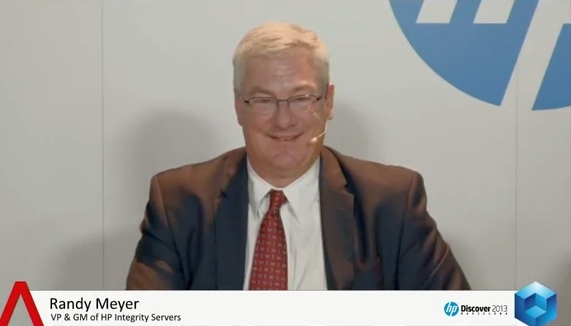 NEWS
NEWS
 NEWS
NEWS
 NEWS
NEWS
![]() Dave Vellante and John Furrier brought theCUBE to Europe, covering the 2013 edition of HP Discover Conference in Barcelona. Broadcasting live from Fira Barcelona GranVia, theCUBE co-hosts put the spotlight on the top tech athletes attending the event, covering several current trends in the tech business.
Dave Vellante and John Furrier brought theCUBE to Europe, covering the 2013 edition of HP Discover Conference in Barcelona. Broadcasting live from Fira Barcelona GranVia, theCUBE co-hosts put the spotlight on the top tech athletes attending the event, covering several current trends in the tech business.
One of the key guests, Randy Meyer, VP & GM of HP Integrity Servers, discussed the new features in HP’s portfolio, the challenges and the future vision of the company.
“Server market share is looking good right now,” assessed Furrier, and Meyer agreed: “We’re actually seeing significant improvements and that’s a testament to great products, great technology and great execution.”
“One of the greatest things about coming here at this event is getting to interact with our customers face to face, and hear about what they want to do. Unix customers want to take risk out of their business. IT is what drives their business and customers see three times the performance improvement compared to previous generations.”
Furrier admitted discussing off-camera with his co-host, Dave Vellante, about the old becoming new again: “System Management is back in, the Unix system is back, so is the mindset of large scale clustered computing. The mainframe never went away, and now the software mainframe is actually the cloud.”
“Everything old is new again is exactly right,” agreed Meyer. “As everyone’s got a mobile device which can be turned into a payment device, Always on, Mission Critical, serve the customer 24/7 equipment is way back in style.”
“The UNIX business focused on lots of different customers, from the smallest kind of businesses to the biggest.
The non-stop piece focused on some specific business applications: 1) Payments – if you make a payment anywhere in the world, chances are it’s going to go through a non-stop system; 2) Mobile phones – over 400 million subscribers around the world; their mobile phones run on a non-stop system on the backend. If that system is not running, your phone doesn’t work. 3) Reservation Systems; 4) High-end transaction systems
The scale-up X86 business is really fascinating – it’s where the world is moving to for a variety of applications, and there’s two different business models here. You see people like SAP putting big focus on in-memory data base – you need large memory footprint for that, large core footprint, and huge I/O because there’s still storage behind that. We’ve designed some appliances and some engineered solutions for SAP HANA where we can go build large scale systems and doing some exciting work around that, up into the 24 TB of memory footprints,” explained Meyer.
“TheX86 is known as Project Odyssey,” clarified Vellante, “and then there’s Project Kraken. Can you provide more details about them?” he asked.
“Project Kraken is really something that we’ve embraked on along with SAP around these large scale memory things, so large core counts, 16 socket systems and up into these 24 TB kinds of memory footprints, pairing them with the SAP HANA environment and the Saphire got rave reviews from people.”
“Why are people still using Unix?” asked Vellante. “There’s a lot of custom code in there.”
“You have to think about why people used Unix in the first place: huge skill-base out of the marketplace. They are looking for resilience, reliability, scale. Additionally, they look at things like clustering and failover, and it’s not just the box and the operating system, it’s things like serviceguard.”
“Conversations are like: ‘Here’s where I’m seeing growth; how can you help me with that?’ – ‘Where is my next capacity coming from ?’ – ‘How do I get more memory?’ – ‘How do I get more storage?’ – ‘How do I leverage things like the new 3PAR technology that’s coming out?’ – ‘How do I take advantage of all the cool things that are out here?’ – ‘How do I leverage UNIX in my Blades environment and in Converged Infrastructure?'” Meyer explained.
“In the non-stop space there’s a lot of excitement. In addition to all the stuff we’ve been doing in the Integrity space, we’re going to port the entire non-stop stack to an X86 architecture. Our customers will get a tremendous amount of choice,” promised Meyer.
“What do you see as the next step?” inquired Furrier.
“The demand for always-on mission critical is going through the roof; it’s a business process discussion. These business processes can be always there. The question for us is how do we serve that as things move to the cloud – there’s going to be applications sitting on the public cloud, there’s going to be private cloud technologies deployed inside the companies, there’s going to be traditional IT that has a lot of existing data and a lot of legacy business processes around them, so how do we take and integrate all that so that, at the end of the day, it looks real-time, modern and seamless to the end user?”
THANK YOU